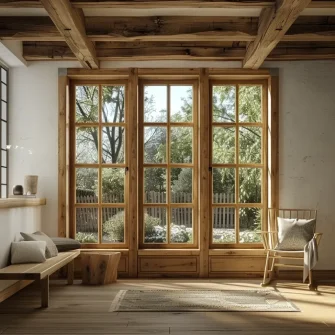Best choose
Wood
Wood remains a timeless choice for windows and doors in the United States. Beloved for its natural warmth, tactile appeal, and design versatility, wood frames have adorned homes for centuries – from historic estates to modern custom builds. Despite competition from materials like vinyl, fiberglass, aluminum, and composite, wood continues to capture the hearts of homeowners and architects who value authentic style and robust insulation.

Natural Warmth and Beauty
Wood exhibits an authentic texture and grain that can be stained, painted, or left natural.
Timeless Appeal
Wood windows and doors never truly go out of style. They often boost a home’s resale value, especially in neighborhoods that prioritize historical or high-end aesthetics.
Sustainability
Sourced responsibly, wood can be a renewable material. Many manufacturers partner with certified forestry programs to minimize environmental impact.
Key Features of Wood Windows and Doors
- Superior Insulation
Wood’s cellular structure provides natural thermal barriers, keeping hot or cold air at bay. Pairing with double- or triple-pane glass further enhances energy efficiency. - Quiet, Natural Acoustics
Wood’s density can help dampen external noise, promoting a quieter interior environment. Particularly beneficial in busy urban settings. - Versatile Finishes
Owners can customize frames with paint, stain, or even split-finish (painted exterior, stained interior). Over time, re-finishing can update the style without replacing the entire unit. - Renewable Resource
Responsibly harvested wood supports sustainable forestry efforts. Many manufacturers use FSC- or PEFC-certified lumber to ensure minimal environmental impact.



Frequently Asked Questions (FAQ)
Are wood windows and doors suitable for coastal or very humid regions?
Yes – provided they’re crafted from moisture-resistant species (like cedar or mahogany) or treated/engineered to endure humidity. High-quality finishes and consistent maintenance are crucial in wet environments.
How often do I need to repaint or restain wooden frames?
This varies based on climate, exposure, and finish quality. Some finishes last 2–5 years before showing wear; others, especially premium coatings, can last longer. Monitoring your frames annually helps you refinish at the right time.
Do wood frames come prefinished from the factory?
Many manufacturers offer factory-applied stains, paints, or clear coats. This ensures professional, even coverage and can extend the frame’s lifespan. You may still need occasional touch-ups down the road.
How can I improve the energy efficiency of my wood windows or doors?
Pairing wood frames with double- or triple-pane Low-E glass and modern weatherstripping significantly boosts insulation. Regularly sealing any gaps or cracks also helps maintain optimal energy performance.
Is there a risk of warping or swelling in changing temperatures?
Wood can expand or contract due to humidity or temperature shifts. Using engineered or properly kiln-dried wood reduces these risks. Maintaining a stable indoor environment also helps keep frames dimensionally stable.
Are wooden doors more secure than other materials?
Security primarily depends on door thickness, lock hardware, and frame construction rather than material alone. Solid wood doors (and well-built frames) can be highly secure when paired with robust locks and multi-point systems.
Does wood cost more than vinyl or aluminum?
Often, yes. While pine or basic wood lines might be priced competitively, hardwoods and custom designs typically exceed the cost of standard vinyl or basic aluminum frames. However, many homeowners find the premium worthwhile for wood’s unique beauty and long-term value.
Do wood doors or windows add more value to my home than other materials?
They can. Wood’s timeless elegance and high-end reputation often appeal to buyers – particularly in historic districts or luxury markets. Well-maintained wood features can boost curb appeal and perceived quality, potentially raising resale value.


